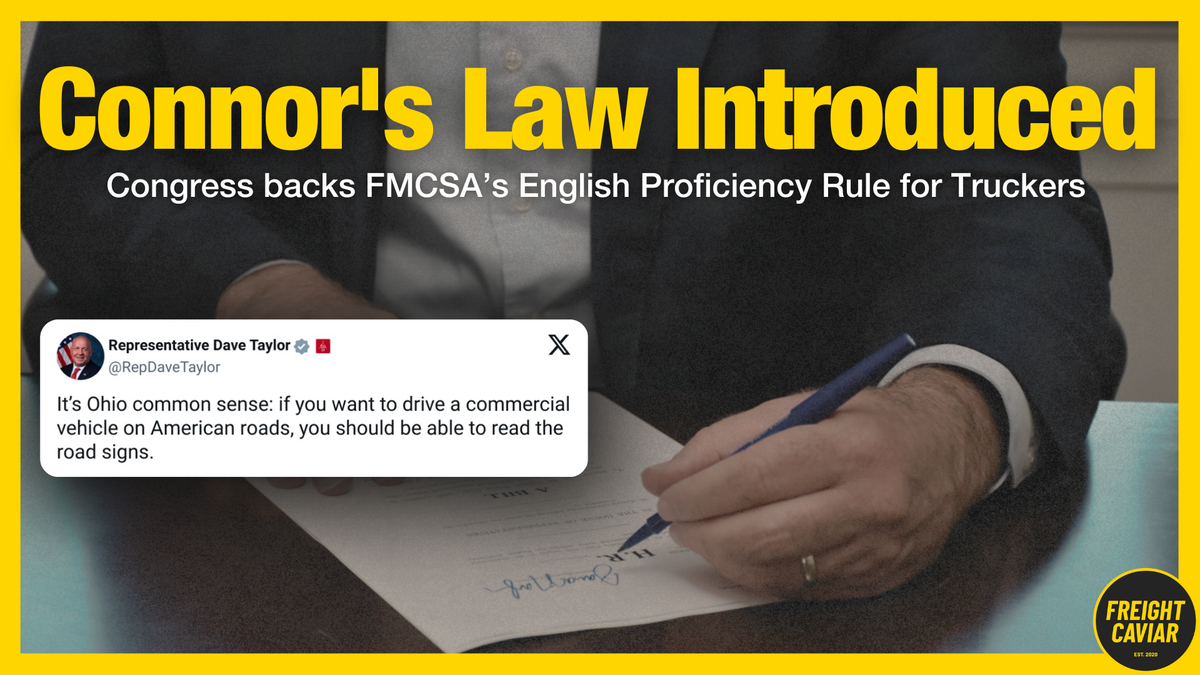🎣 Trucking Locked Down
Plus: a potential $12B tech-broker merger, rejection rates crossing 10%, and FMCSA signaling the end of ELD self-certification, and more.
Today’s FreightCaviar newsletter covers the new English proficiency enforcement for CDL holders—but this expanded article dives deeper into the debate, the risks, and the potential disruptions for freight.

President Trump’s recent executive order is sending ripples across the freight industry, and not just because it revives a decades-old regulation.
The April 28 order mandates strict enforcement of the English language requirement for all U.S. CDL holders—a rule that hasn’t been enforced this aggressively in nearly a decade. And with the Commercial Vehicle Safety Alliance (CVSA) voting to place non-proficient drivers out-of-service starting June 25, freight brokers, carriers, and drivers are scrambling to understand what this actually means for the road ahead.
Let’s be clear: the rule itself isn’t new. Since 1937, drivers have been federally required to “read and speak the English language sufficiently” to converse with the public, respond to officials, and understand road signs. But in 2016, the FMCSA issued guidance under the Obama administration directing inspectors not to place drivers out of service solely for language issues.
That era is over.
Under the new Trump directive, FMCSA must rescind that 2016 guidance, and CVSA has already acted, with enforcement kicking in this summer. If a driver can’t demonstrate proficiency at a roadside inspection, they’ll be shut down on the spot.
FMCSA issued new guidance on May 20, 2025, outlining a two-step English proficiency assessment for roadside inspections:
U.S. Transportation Secretary Sean P. Duffy emphasized safety: “Americans are a lot safer on roads alongside truckers who can understand and interpret our traffic signs.”

On May 29, Congressman Dave Taylor (OH-02) and Representative Harriet Hageman (WY-AL) introduced Connor's Law, aiming to codify the executive order into federal law. Named after 18-year-old Connor Dzion, who was killed in 2017 by a trucker unable to read English warning signs, the bill seeks to:

Karl Fillhouer, VP of Sales and Operations at Circle Logistics, told FreightCaviar he’s already seeing the fallout.
“More and more, not just brokers, but even customers are insisting on English-speaking people because of what safety problems are created with a lack of communication,” he said. “It goes beyond safety. It goes to liability.”
Fillhouer also noted that shippers are increasingly requiring English proficiency from carriers up front.
"We're hearing that some contracts are even being modified to include fines or refusal to pay if a non-English proficient driver shows up to the dock."
The implications aren’t just legal, but also deeply operational.
Pre-trip inspections, bill of lading signatures, hazmat communication, and even basic dock interactions hinge on a shared language.
Fillhouer added, “The things that you or I would see on a sign and immediately know what it means—construction detours, weather-related alerts—those are getting missed. That can create real safety problems.”
Fillhouer also raised the issue of onboard tech and workflows.
“Oftentimes, those pre-checks are written in English, and it might be something on their onboard computer they have to enter. They have to understand what they're doing.”
The new enforcement could sideline a significant slice of the driver population.
Insurance experts say roughly 10% of U.S. truck drivers may not meet the English proficiency requirement. And with more than 3 million CDL holders in the country, that could mean as many as 300,000 drivers at risk of being taken off the road.
Legal experts speaking to FreightWaves are already warning of downstream impacts.
DOT attorney Chris Eckhart noted, "Out-of-service violations usually count more than other violations, so it could adversely impact CSA scores."
Xiao Wang, CEO of Boundless Immigration, added that carriers who rely on foreign-born drivers, including those on H-2B and EB-3 visas, may need to overhaul hiring and retention policies to stay compliant.
Carriers could invest in ESL training or even shift recruitment strategies to focus on second-generation immigrants or fluent drivers.
It’s also important to note that drivers from regions with strong immigrant communities—including Chicago, Texas, and California—may face disproportionate scrutiny.
Behind the scenes, many brokers have long served as informal translators and crisis managers for communication issues.
When asked whether brokers have been compensating for language gaps, Fillhouer said: “Some of them possibly. We don't do a good job in this country of enforcing all the laws we have. Even though the laws have been on the books for a while, there needs to be a pre-push in making sure different language speakers have that understanding and have been trained in it.”
That gray area—between enforcement and empathy—is where many brokers and carriers now find themselves. "There needs to be a nurturing period," Fillhouer added. "It can't just be black and white."
Todd Spencer, President of OOIDA, backs the move. “Truckers must be able to read road signs, communicate with law enforcement and respond in emergencies,” he said. “When that doesn’t happen, people get hurt—or worse.”
ATA’s Dan Horvath echoed support, noting, “We look forward to working with FMCSA and law enforcement on an objective, consistent, and effective enforcement standard.”
Online, the order has triggered a fierce and often emotional debate. In a Reddit thread on r/Truckers with over 400 comments, drivers traded stories and opinions. Some welcomed the rule: “This is a good thing. I wouldn’t be able to drive in any other country if I didn’t speak the language,” wrote one user. Another shared, “I’ve had to talk to customers for drivers who couldn’t even say where they were.”
But others raised red flags. “Who decides what’s proficient? Is there a standard or just what the inspector says?” asked one top comment. Another driver wrote, “I worked with guys who couldn’t speak a lick of English, but they could outdrive anyone. This is going to push out a lot of safe drivers.”
A recent op-ed in TheTrucker pointed out a deeper challenge: the rule may enforce English proficiency, but it can’t legislate kindness or understanding.
Some drivers worry about being unfairly targeted due to accents, dress, or cultural differences. Many foreign-born drivers have proven track records but now face additional stress. “Painting all drivers born outside the U.S. with the same brush is wrong,” the op-ed argues.
With immigrant drivers making up nearly 20% of the U.S. trucking workforce, many are anxious about the impact. ESL-friendly CDL schools exist, but road tests and interactions remain English-only. The industry’s challenge will be enforcing safety standards fairly without alienating essential workers.
Starting June 25, any driver who can’t prove they speak and read English may be placed out-of-service during inspections. CVSA has said it will issue clear guidance to inspectors, but many in the industry are bracing for subjective or uneven enforcement.
Matthew Leffler, logistics attorney and industry commentator, summarized the issue well: "The rule exists. The question is whether enforcement will be consistent."
Whether the order leads to safer roads or just fewer drivers, the industry is already adjusting—quietly screening harder, rewriting contracts, and making tough calls about who gets a load.
Stay tuned: this isn’t just a regulation story. It’s a capacity story. It’s a liability story.
Join over 14K+ subscribers to get the latest freight news and entertainment directly in your inbox for free. Subscribe & be sure to check your inbox to confirm (and your spam folder just in case).